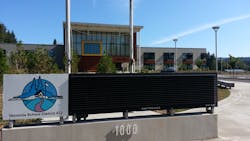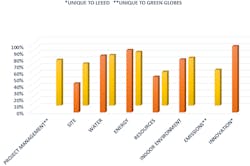One Project, Two Green-Building Certifications: LEED and Green Globes
As one who assists commercial-building owners in achieving green-building certification, I have written several articles comparing rating systems (see “What Owners Need to Know About ... Green-Building Rating Systems” and “LEED and Green Globes”). All of the conclusions drawn in those articles were based on projects certified under one rating system or another, never more than one. In this blog post, I discuss a project that has achieved both LEED and Green Globes certification.
In 2012, Vernonia (Ore.) School District completed construction of a new, approximately $40 million, 150,000-sq-ft building designed to house students in grades K-12. The new school replaced a 60-year-old high-school facility damaged by severe flooding five years before. The new building serves more than 500 students in this city of a little more than 2,000 residents. From the onset of the project, the school district committed to providing a sustainable school to serve as a model for students and to operate more efficiently than the older, smaller building it was replacing.
In August 2014, the new building was awarded two green-building certifications: Three Green Globes and LEED Platinum. With both systems utilizing four tiers of certification, Three Green Globes can be considered comparable to LEED Gold:
LEED Green Globes
Platinum Four Green Globes
Gold Three Green Globes
Silver Two Green Globes
Certified One Green Globe
Although both certifications represent a significant accomplishment for the district, recognizing high levels of energy, water, and environmental efficiency, the difference in certification levels raises an interesting question: Is Green Globes, which has been thought of as less stringent than LEED, actually the more rigorous rating system? Or did an equally rigorous LEED rating system fall victim to “point chasing” on this project?
The school was certified under the 2007 version of LEED BD+C: Schools, which since has been replaced by the 2009 version and LEED v4. The requirement for Platinum certification under the 2007 version is 58, or 73 percent, of a possible 79 points, which is exactly what the school achieved. It does not appear the school would have earned Platinum with the higher thresholds of the 2009 version and LEED v4.
The Green Globes standard under which the building was certified was the New Construction version launched in 2013 and still substantially in effect. Under that, the project received 71 percent of the applicable points, with the threshold for the next tier being 85 percent. It should be noted the Green Globes rating starts with 1,000 possible points, but allows non-applicable points to be excluded from the available point count. In this case, there were 72.5 points considered not applicable. For example, in the area of water assessment, 30 of the possible 110 points were deemed not applicable. Nearly half of those 30 points were related to once-through water-consuming devices, none of which was used.
A comparison of the various LEED and Green Globes assessment areas shows the following percentages achieved:
Despite some differences—for example, there is more emphasis in LEED on the engagement of a LEED accredited professional, one of the Innovation points, while in Green Globes, integrated design process, part of Project Management, is strongly encouraged—the attainment of possible (or available) points in the assessment areas common to both rating systems shows a fairly strong correlation.
My conclusion based on this project (in which neither I nor my firm had a role) is that the two systems are comparable in terms of adherence to green best practices and published standards. Green Globes has the advantage in terms of consistency and transparency, as independent verification is done face-to-face, rather than anonymously. No data on soft costs—consultant’s fees, additional design costs, etc.—was available to me; however, based on anecdotal evidence, data from other projects, and my own experience with both LEED and Green Globes, I am confident the total cost of certification was significantly less for the equally vigorous Green Globes rating.
About the Author
Larry Clark
A member of HPAC Engineering’s Editorial Advisory Board, Lawrence (Larry) Clark, QCxP, GGP, LEED AP+, is principal of Sustainable Performance Solutions LLC, a South Florida-based engineering firm focused on energy and sustainability consulting. He has more than two dozen published articles on HVAC- and energy-related topics to his credit and frequently lectures on green-building best practices, central-energy-plant optimization, and demand-controlled ventilation.


